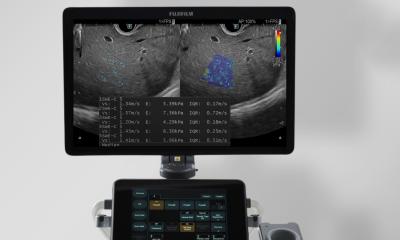The 1st tele-ultrasound via satellite
Robot Estele probes patient onboard ship and transmits images to France
The first robotised tele-ultrasound examination has been performed by participants in the European Mobile And Robotised Tele-echography (MARTE) project, in collaboration with Robosoft, specialist in the development and production of service robot systems.

Using Robosoft’s Estele, a tele-operated robotic system, an expert clinician can perform remote echographic diagnosis as if in the same room as the patient.
The system is based on a 3 kg, 4-axis ultrasound Probe Holder Robot, which can be positioned on a patient by any on-the-spot medical assistant, is controlled by the distant specialist at the Remote Master Controller. Via the bi-directional ‘visio’ conferencing system, the specialist receives the ultrasound images and can see and communicate with the patient.
Communication can be via ISDN (known as RNIS in France) or a specific communication link, such as satellite, as used in this the first tele-ultrasound examination of a patient who was on the ship Saphire, owned by Cyprus-based Louis Cruise Lines.
Researchers at PRISME – a new multidisciplinary research institute that includes some 170 university researchers, engineers, technicians and doctoral students at several locations (Bourges, Orléans, Chartres, Châteauroux, Paris) – initially spent a month becoming familiar with the software in the Estele robot, which is entirely controlled by the robuBOX, a universal robotics engine adapted for the growing service robots market. The team then developed and implemented software for internet communication via satellite between the Remote Master Controller in France and the remote Probe Holder Robot on the ship, which was sailing in the Mediterranean.
‘These kinds of projects show the soundness of the generic approach used in the robuBOX,’ said Vincent Dupourqué, CEO of Robosoft. ‘The standard tele-ultrasound robot was originally delivered for use in a classic video-conferencing system over phone lines. Thanks to the robuBOX development toolkit, included with the standard robot, a customer can add his own functionalities, and can also integrate the robot into a larger system.’
For the project the PRISME Institute team adapted Estele’s software using Microsoft Robotics Developer Studio (see http://www.microsoft.com/robotics)
Several robots equipped with preliminary versions of the robuBOX have already been deployed: Estele, the tele-ultrasound robot; robuCAB, an autonomous GPS-guided vehicle, and general-purpose mobile platforms such as the robuLAB10 for domestic help or the robuROC for security and military applications.
Beyond professional applications, Robosoft believes the era of personal robotics is approaching fast and that its service robots, called robuters, will be part of everyday life within five years (i.e. they will not only be utilised for amusement, education, culture and healthcare, but also for assistance for the elderly and handicapped, etc.)
To bring these applications to life, Robosoft already integrates 80% of programming complexity into the robuBOX, a module programme using the Microsoft Robotics Developer Studio. Although robuBOX is incorporated into the heart of Robosoft robots, it can also be licensed to robotics integrators and manufacturers for mass production.
According to the Japan Robotics Association’s predictions, the world market for service and personal robotics will reach 17 billion dollars by 2010.
Details: www.robosoft.com
01.09.2008










